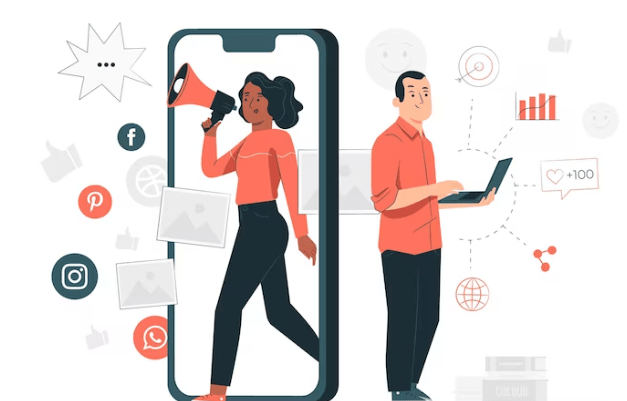TABLE OF CONTENT
ToggleIntegrated Marketing Communications
Hey Mumbai University SYBA IDOL students! Today, we’re diving into the fascinating world of Advertising , exploring about – “ Integrated Marketing Communications“. We have a comprehensive set of topics to cover that will help you understand the key concepts and practical applications of IMC. Here’s what we’re going to explore today:
We’ll start with a Quiz Time to check your progress. Through this quiz, you’ll test your knowledge on several important statements and questions related to IMC. For example, we will determine whether marketers rely primarily on media advertising, understand the centralized messaging function of IMC, and discuss its goal of generating both short-term financial returns and long-term brand value. We’ll also cover topics such as the non-personal nature of advertising, the credibility of publicity, the initial steps in the IMC planning process, and definitions from the American Marketing Association.
Next, we’ll look at multiple-choice questions that address various aspects of IMC. You’ll learn about the process of assimilating mass-media advertisements with other promotional elements, the primary goal of an integrated marketing communications program, and the most widely discussed forms of promotion. We will also cover tools like telemarketing and sales promotions, including consumer-oriented promotions and the role of publicity and public relations.
After the quiz, we will dive into the theory questions. We will define Integrated Marketing Communication (IMC), state its main tools, and discuss its importance. Furthermore, we will go over the steps involved in framing an effective IMC strategy, ensuring you have a clear understanding of how to develop and implement these communications.
By the end of this session, you will have a thorough grasp of the fundamentals of Integrated Marketing Communications, its significance in the advertising world, and how to apply these concepts effectively. So, SYBA IDOL Mumbai University students, get ready to unwrap the “ Integrated Marketing Communications” with customized IDOL notes just for you. Let’s jump into this exploration together


STATE THE FOLLOWING STATEMENT IS TRUE OR FALSE AND EXPLAIN IT:-
- As marketers embraced the concept of integrated marketing communications, they began to reply primarily on media advertising.
ANS – The following statement is False.
EXPLANATION – As marketers embraced the concept of integrated marketing communications, they began asking their ad agencies to coordinate the use of a variety of promotional tools rather than relying primarily on media advertising. A number of companies also began to look beyond traditional advertising agencies and use other types of promotional specialists. - The integrated marketing communications approach calls for a centralized messaging function so that everything a company says and does communicates a common theme and positioning.
ANS – The following statement is True
EXPLANATION – The integrated marketing communications approach seeks to have all of a company’s marketing and promotional activities project a consistent, unified image to the marketplace. It recognizes that every customer interaction with a company or brand across a host of contact points represents an opportunity to deliver on the brand promise, strengthen customer relationships, and deepen loyalty. - The goal of integrated marketing communications (IMC) is to generate both short-term financial returns and build long-term brand and shareholder value.
ANS – The following statement is True
EXPLANATION -Integrated marketing communications is a strategic business process used to plan, develop, execute, and evaluate coordinated, measurable, persuasive brand communications programs overtime with consumers, customers, prospects, employees, associates, and other targeted relevant external and internal audiences. The goal is to generate both shortterm financial returns and build long-term brand and shareholder value. - The non-personal nature of advertising means that there is generally ample opportunity for immediate feedback from the message recipient.
ANS – The following statement is False
EXPLANATION The non-personal nature of advertising means that there is generally no opportunity for immediate feedback from the message recipient (except in direct-response advertising). Therefore, before the message is sent, the advertiser must consider how the audience will interpret and respond to it. - An advantage of publicity over other forms of promotion is its credibility.
The following statement is True
ANS – EXPLANATION: Consumers generally tend to be less\ sceptical toward favourable information about a product or service when it comes from a source they perceive as unbiased. - The first step in the IMC planning process is to review the marketing plan and objectives.
ANS – The following statement is True
EXPLANATION: The first step in the IMC planning process is to review the marketing plan and objectives. Before developing a promotional plan, marketers must understand where the company (or the brand) has been, its current position in the market, where it intends to go, and how it plans to get there
Follow Us For More Updates
CHOOSE THE CORRECT OPTION :-
1.According to the American Marketing Association’s definition of marketing, which of the following statements is true?
A) Most marketers are seeking a one-time exchange or transaction with their customers.
B) The focus of production- driven companies is on developing and sustaining relationships with their customers.
C) Successful companies recognize that creating and delivering value to their customers is extremely important.
D) Though marketing plays an important role in developing relationships with customers, it does not help in maintaining them.
E) By definition, a marketing transaction has to involve the exchange of money.
Ans – C) Successful companies recognize that creating and delivering value to their customers is extremely important
2. The process of assimilating mass-media advertisements with other promotional elements such as direct marketing, public relations, and sales promotion is known as
A) Media fragmentation.
B) Micromarketing.
C) Integrated Marketing Communications.
D) Social Media
E) Digital Advertising
Ans – C) Integrated Marketing Communications
3. The primary goal of an integrated marketing communications program is to
A.) Have a company’s entire marketing and promotional activities project a consistent, unified image to its customers.
B.) Control all facets of a product’s distribution.
C.) Communicate with customers primarily through mass-media advertising.
D.) Have complete control over all the channel partners in the distribution channel and to slow down the rate of diffusion of a new product among the customers.
E.) Create a strong distribution network, via marketing, that is capable of destabilizing any competition.
Ans – A.) Have a company’s entire marketing and promotional activities project a consistent, unified image to its customers
4..The best-known and most widely discussed form of promotion is
A.) Personal Selling.
B.) Sales Promotion.
C.) Direct Marketing.
D.) Advertising.
E.) Publicity/Public Relation.
Ans – D.) Advertising
5.____________is a tool of direct marketing that is used to call customers directly and attempts to sell them products and services or qualify them as sales leads.
A.) Bait advertising
B.) Buzz marketing 17
C.) Telemarketing
D.) Switch marketing
E.) B2B marketing
Ans – C.) Telemarketing
6.___________ includes those marketing activities that provide extra value or incentives for purchasing a product, such as coupons and premiums.
A.) Direct Marketing
B.) Advertising
C.) Public Relations
D.) Sales Promotion
E.) Publicity
Ans – D.) Sales Promotion
6.Sales promotions targeted at the ultimate users of a product, such as sampling, coupons, contests, or sweepstakes, are part of ________________.
A.) Consumer-oriented Sales Promotion.
B.) Trade-oriented Sales Promotion.
C.) Buzz Promotion.
D.) Bait-and-Switch Sales Promotion.
E.) Channel-initiated Sales Promotion.
Ans – A.) Consumer-oriented Sales Promotion
7._________refers to non-personal communication regarding an organization, product, service, or idea not directly paid for or run under identified sponsorship.
A.) Advertising
B.) Sales Promotion
C.) Publicity
D.) Public Relations
E.) Telemarketing
Ans – C.) Publicity
8.When an organization systematically plans and distributes information in an attempt to control and manage its image and the nature of the publicity it receives, it is engaging in a function known as
A.) Buzz Marketing.
B.) Reactive disinformation.
C.) Bait-and-switch Marketing.
D.) Public Relations.
E.) Sales Promotion.
Ans – D.) Public Relations
THEORY QUESTIONS :-
Question 1:- Define Integrated Marketing Communication (IMC).
Integrated Marketing Communication (IMC) is a comprehensive strategy in marketing that focuses on harmonizing various communication tools and promotional elements. The main objective is to convey a consistent and unified message to target audiences. IMC involves strategically coordinating different forms of persuasive communication programs with customers and prospects over time. This ensures that all promotional activities, including advertising, public relations, sales promotion, direct marketing, and personal selling, work together seamlessly to promote a particular product or service effectively.
Question 2 :- State the main tools of Integrated Marketing Communication.
Introduction:
Today, we’re setting sail into the exciting seas of Integrated Marketing Communication (IMC). But hold on, no need for stress – we’re breaking it down into simple language for a smooth journey. IMC is like the master plan that brings all the ways companies talk about their products together. It’s the superhero behind ads, promotions, and more. So, buckle up, and let’s explore the world of IMC in a way that makes it a piece of cake!
Exploring IMC Tools:
-
Advertising:
- Definition: Paid messages through TV, radio, or online to spread the word.
- Example: Commercials, radio jingles, online banners.
- Details: Companies use ads to make sure you know about their cool stuff.
-
Public Relations (PR):
- Definition: Keeping a positive image through media, events, and press releases.
- Example: Media relations, event sponsorships, community activities.
- Details: PR is like the friendly face of a brand, making sure everyone feels good about it.
-
Sales Promotion:
- Definition: Short-term perks to boost sales – think coupons and discounts.
- Example: Coupons, discounts, contests.
- Details: Companies use these to make you excited about grabbing a sweet deal.
-
Direct Marketing:
- Definition: Communicating directly with you – via mail, email, or even a call.
- Example: Direct mail, email campaigns, telemarketing.
- Details: Direct marketing is like a personal letter from a brand right to your doorstep.
-
Personal Selling:
- Definition: Face-to-face interactions to make sales and build relationships.
- Example: Sales presentations, product demos, meetings.
- Details: Salespeople become superheroes, showing off products and answering your questions.
-
Digital Marketing:
- Definition: Online efforts like social media, blogs, and search engine ads.
- Example: Social media campaigns, blog posts, search engine ads.
- Details: It’s how brands rock the digital world, connecting with you online.
Why Does IMC Matter?
Now, you might wonder – why does IMC matter in the grand scheme of things? Well, when all these tools work together, they create a mega message that everyone understands. It’s like a band playing in harmony, making the audience (that’s you!) excited. Businesses use IMC to tell you about their cool stuff, and when they do it well, everyone’s a winner.
Conclusion:
So, here’s the scoop – Integrated Marketing Communication is the secret sauce behind how companies share their fantastic products. From catchy ads to personal selling, it’s like a symphony of messages that just click. When a brand is killing it on different platforms, giving you awesome discounts and content, you know it’s the power of IMC at play. It’s a win for the business, and it’s a win for you, the savvy consumer. There you have it – IMC demystified, and you’re ready to conquer the marketing seas!
Question 3 :- State the importance of Integrated Marketing Communication
Introduction:
Today, let’s dive into the world of Integrated Marketing Communication (IMC), a superhero strategy for businesses. IMC is like the maestro that orchestrates all the ways a company talks about its goodies, making sure the message is crystal clear. Now, don’t worry, we’re going to unravel IMC in simple terms, making it a breeze to understand. So, buckle up for a stress-free journey into the land of effective communication!
Unlocking IMC Magic:
-
Why is IMC a Big Deal? IMC is like the magic wand that businesses wave to ensure their messages are not all over the place but are singing the same tune. It’s like when you tell a story, and every part fits together – that’s IMC.
-
Consistent Message: Imagine a company’s ads, social media posts, and posters all shouting the same cool things about a product. That’s IMC making sure the message is as clear as day, like the sun in the sky.
-
Boosting Effectiveness: Now, let’s talk about how using IMC is like having a secret weapon. When a company lines up its ads, promos, and online stuff to say the same story, it’s like a superhero team-up. The result? People notice and get excited, leading to more sales.
-
Building Relationships: Ever had a friend who’s just super consistent and awesome? Well, businesses want to be that friend to you. IMC helps them send positive messages your way through ads, social media, and more. It’s like building a friendship with a brand!
-
Getting Ahead in the Game: In a world full of brands vying for attention, IMC is the secret sauce that makes one stand out. It’s like having a unique superhero costume – you can spot them in a crowd. This “stand-out” quality gives companies a competitive edge.
-
ROI – Making Every Penny Count: Okay, let’s talk money. IMC is like a wise financial advisor for businesses. When they align all their marketing efforts, it’s not just effective, it’s efficient. Every penny spent becomes a superhero penny, working harder to bring in positive results.
Conclusion:
Integrated Marketing Communication ensures businesses speak in one clear voice, making them stand out, connect with you, and become memorable. It’s not just a strategy; it’s a game-changer, bringing harmony to the marketing symphony.
Question 4 :- What are the steps involved in framing Integrated Marketing Communication?
Introduction:
Today, let’s unravel the magic behind Integrated Marketing Communication (IMC) planning. It’s like creating a superhero strategy for businesses to ensure their marketing efforts are super effective and coordinated. Don’t worry; we’re breaking down the process into simple steps that will make you feel like a marketing superhero in no time. So, let’s dive into the world of IMC planning without any stress!
Navigating the IMC Adventure:
-
Starting with the Basics: IMC planning is like crafting a roadmap for a company’s messages. Think of it as creating a treasure map to connect with customers. The first step is to review the current marketing plan and objectives. Imagine it as checking your starting point and the destination on your adventure map.
-
Understanding the Landscape: Now, we’re on a journey through the internal and external world of a company. Conducting a situation analysis is like putting on your explorer hat and looking for clues. We’re checking the company’s strengths, weaknesses, opportunities, and threats – just like finding hidden treasures and avoiding traps.
-
Choosing Your Communication Tools: Picture this: You’re about to send a message to a friend. Will you send a letter or a text? In IMC, understanding the communication process is like choosing the right tool. Is it a social media ad or a print ad? It depends on where your friend (target audience) hangs out the most.
-
Setting Goals – Your Quest’s Purpose: Every hero needs a quest, right? In IMC, setting communication goals and objectives is like defining the purpose of your adventure. If the quest is to make more people aware of a cool product, then that’s the mission you’re gearing up for.
-
Counting Your Coins – The Budget: Now, imagine you have a bag of gold coins, and you need to spend them wisely. Determining the budget for the promotional program is like planning how many coins you’ll use for each part of your adventure. Maybe more for online ads, a few for events, and some for public relations.
-
Building Your Toolkit – Developing the IMC Program: Imagine you’re getting ready for an epic quest. In IMC, developing the program is like packing your toolkit. What weapons (tools) will you use? Outline your strategies and budgets for advertising, public relations, and social media – each tool has its role in your quest.
-
Embarking on the Adventure – Implementation and Evaluation: It’s showtime! Implementing the plan is like setting off on your quest. Keep an eye on your map (plan), monitor online engagement, track sales data – it’s like checking your compass to ensure you’re on the right path. Continuously assess the adventure’s effectiveness and make adjustments if needed.
Conclusion:
Reviewing objectives, analyzing the situation, understanding the communication process, setting goals, determining the budget, developing the program, and implementing and evaluating – you’re equipped to be a marketing hero. May your IMC adventures be successful, and may your marketing strategies shine like beacons in the business world!
Important Note for Students :– Hey everyone! All the questions in this chapter are super important!
